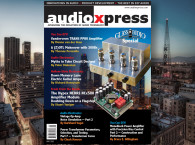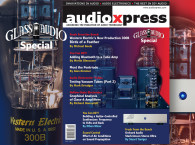“Glass audio” has been growing in popularity among average audio enthusiasts for the past decade. Music-loving consumers worldwide enjoy the look and sound (i.e., the “warmth”) of tube amps, and innovative companies are creating demand by selling systems featuring tubes, iPod/MP3 hookups, and futuristic-looking enclosures. I suspect hybrid modern/retro designs will continue to gain popularity.
Many serious audiophiles enjoy incorporating glass tubes in their custom audio designs to create the sounds and audio system aesthetics to match their tastes. If you’re a DIYer of this sort, you’ll benefit from knowing how amps work and understanding topics such as frequency responses. In the April 2012 issue of audioXpress, columnist Richard Honeycutt details just that in his article titled “The Frequency Response of Hollow-State Amplifiers.”
Below is an excerpt from Honeycutt’s article. Click the link at the bottom of this post to read the entire article.
Early electronic devices were intended mainly for speech amplification and reproduction. By the 1930s, however, musical program material gained importance, and an extended frequency response became a commercial necessity. This emphasis grew until, in the 1950s and 1960s, the Harmon Kardon Citation audio amplifier claimed frequency response from 1 to 100,000 Hz flat within a decibel or better. Although today, other performance metrics have surpassed frequency response in advertising emphasis—in part because wide, flat frequency response is now easier to obtain with modern circuitry—frequency response remains a very important parameter …
Just which factors determine the low- and high-frequency limitations of vacuum tube amplifiers? In order to examine these factors, we need to discuss a bit of electric circuit theory. If a voltage source—AC or DC, it doesn’t matter—is connected to a resistance, the resulting current is given by Ohm’s Law: I = V/R. If the voltage source is of the AC variety, and the resistor is replaced by a capacitor or inductor, the current is given by: I = V/X where X is the reactance of the capacitor or inductor. Reactance limits current flow by means of temporary energy storage: capacitive reactance XC does so via the electric field, and inductive reactance XL stores energy in the magnetic field.
Figure 1 – The values of reactance provided by a 0.1-µF capacitor and a 254-mH inductor, for a frequency range of 10 to 30,000 Hz (Source: R. Honeycutt, AX April 2012)
Figure 1 shows the values of reactance provided by a 0.1 µF capacitor and a 254 mH inductor, for a frequency range of 10 to 30,000 Hz. Notice that capacitive reactance decreases with frequency; whereas, inductive reactance increases as frequency increases.
Click here to read the entire article.







